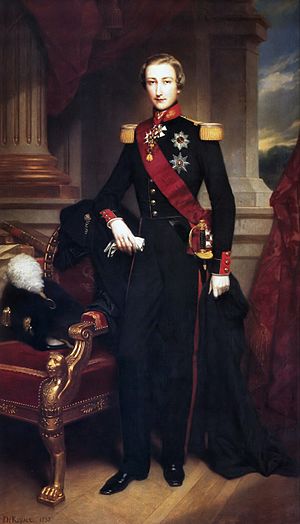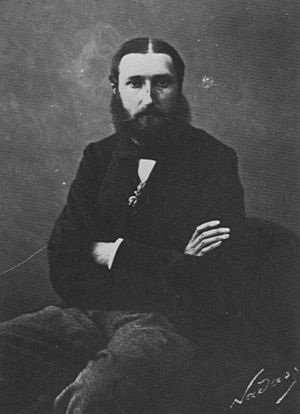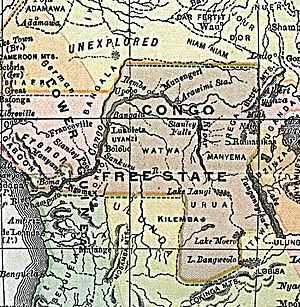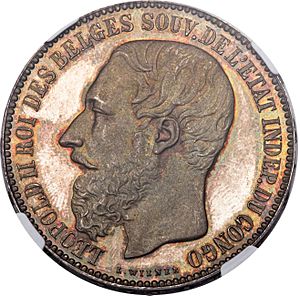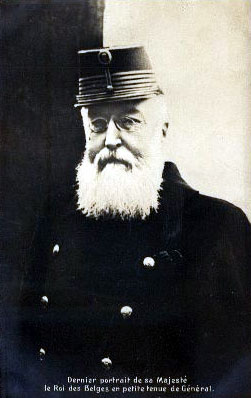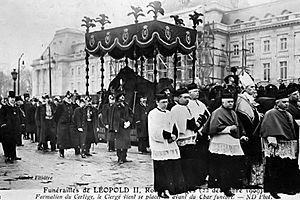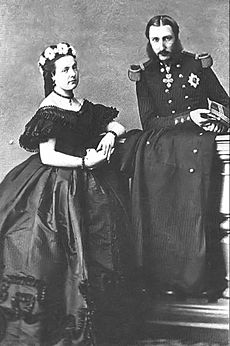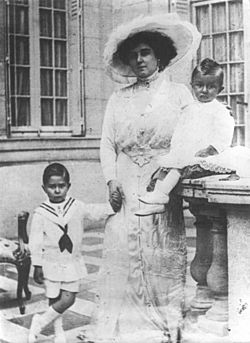Leopold II of Belgium facts for kids
Quick facts for kids Leopold II |
|
|---|---|
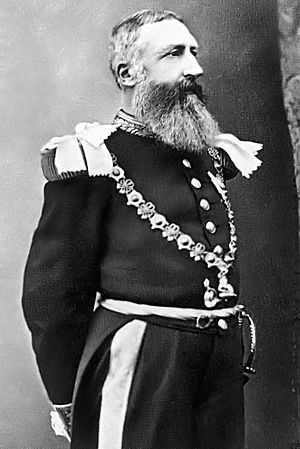 |
|
| King of the Belgians | |
| Reign | 17 December 1865 – 17 December 1909 |
| Predecessor | Leopold I |
| Successor | Albert I |
| Born | 9 April 1835 Royal Palace, Brussels, Belgium |
| Died | 17 December 1909 (aged 74) Royal Palace, Laeken, Belgium |
| Spouse | Marie Henriette of Austria |
| Issue | Louise Marie, Princess of Kohary Prince Leopold, Duke of Brabant Stéphanie, Crown Princess of Austria Clémentine, Princess Napoléon |
| House | House of Saxe-Coburg and Gotha |
| Father | Leopold I |
| Mother | Louise of Orléans |
| Religion | Roman Catholic |
Leopold II (Léopold Louis Philippe Marie Victor) (9 April 1835 – 17 December 1909) was King of the Belgians. Born in Brussels, the second (but oldest surviving) son of Leopold I and Louise of Orléans, he succeeded his father to the throne on 17 December 1865 and was king until his death.
Leopold is mainly remembered as the founder and sole owner of the Congo Free State. He lay claim to the Congo, an area now known as the Democratic Republic of the Congo. He treated the people badly in order to make money. His harsh rule was responsible for the death of between five to 15 million Congo people. The Congo became one of the most infamous international scandals of the early 20th century. Leopold was forced to give control of it to the government of Belgium.
Contents
Early life

Leopold was born in Brussels on 9 April 1835, the second child of the reigning Belgian monarch, Leopold I, and of his second wife, Louise, the daughter of King Louis Philippe of France. The French Revolution of 1848 forced his maternal grandfather, Louis Philippe, to flee to the United Kingdom. Louis Philippe died two years later, in 1850. Leopold's fragile mother was deeply affected by the death of her father and her health deteriorated. She died of tuberculosis that same year, when Leopold was 15 years old.
Leopold's sister Charlotte became Empress Carlota of Mexico in the 1860s. The British monarch at the time, Queen Victoria, was Leopold II's first cousin, since Leopold's father and Victoria's mother were brother and sister.
Marriage and family
At the age of 18, Leopold married Marie Henriette of Austria, a cousin of Emperor Franz Joseph I of Austria and granddaughter of the late Holy Roman Emperor Leopold II, on 22 August 1853 in Brussels. Lively and energetic, Marie Henriette endeared herself to the people by her character and benevolence. Her beauty earned her the sobriquet "The Rose of Brabant". She was also an accomplished artist and musician. She was passionate about horseback riding, to the point that she would care for her horses personally. Some joked about this "marriage of a stableman and a nun", the latter referring to the shy and withdrawn Leopold.
The marriage produced four children: three daughters and one son, Prince Leopold, Duke of Brabant. The younger Leopold died in 1869 at the age of nine from pneumonia after falling into a pond. His death was a source of great sorrow for King Leopold. The marriage became unhappy, and the couple separated after a last attempt to have another son, a union that resulted in the birth of their last daughter, Clementine. Marie Henriette retreated to Spa in 1895, and died there in 1902.
Early political career
As Leopold's older brother, the earlier crown prince Louis Philippe, had died the year before Leopold's birth, Leopold was heir to the throne from his birth. When he was 9 years old, Leopold received the title of Duke of Brabant, and was appointed a sub-lieutenant in the army. He served in the army until his accession in 1865, by which time he had reached the rank of lieutenant-general.
Leopold's public career began on his attaining the age of majority in 1855, when he became a member of the Belgian Senate. He took an active interest in the senate, especially in matters concerning the development of Belgium and its trade, and began to urge Belgium's acquisition of colonies. Leopold traveled abroad extensively from 1854 to 1865, visiting India, China, Egypt, and the countries on the Mediterranean coast of Africa. His father died on 10 December 1865, and Leopold took the oath of office on 17 December, at the age of 30.
Domestic reign
Leopold became king in 1865. He explained his goal for his reign in an 1888 letter addressed to his brother, Prince Philippe, Count of Flanders: "the country must be strong, prosperous, therefore have colonies of her own, beautiful and calm."
Leopold's reign was marked by a number of major political developments. The Liberals governed Belgium from 1857 to 1880, and during its final year in power legislated the Frère-Orban Law of 1879. This law created free, secular, compulsory primary schools supported by the state and withdrew all state support from Roman Catholic primary schools. The Catholic Party obtained a parliamentary majority in 1880, and four years later restored state support to Catholic schools. In 1885, various socialist and social democratic groups drew together and formed the Labour Party. Increasing social unrest and the rise of the Labour Party forced the adoption of universal male suffrage in 1893.
During Leopold's reign other social changes were enacted into law. Among these were the right of workers to form labour unions and the abolition of the livret d'ouvrier, an employment record book. Laws against child labour were passed. Children younger than 12 were not allowed to work in factories, children younger than 16 were not allowed to work at night, and women younger than 21 years old were not allowed to work underground. Workers gained the right to be compensated for workplace accidents and were given Sundays off.
The first revision of the Belgian Constitution came in 1893. Universal male suffrage was introduced, though the effect of this was tempered by plural voting. The eligibility requirements for the Senate were reduced, and elections would be based on a system of proportional representation, which continues to this day. Leopold pushed strongly to enable a royal referendum, whereby the king would have the power to consult the electorate directly on an issue, and use his veto according to the results of the referendum. The proposal was rejected, as it would have given the king the power to override the elected government. Leopold was so disappointed that he considered abdication.
Leopold emphasized military defence as the basis of neutrality, and strove to make Belgium less vulnerable militarily. He achieved the construction of defensive fortresses at Liège, at Namur and at Antwerp. During the Franco-Prussian War, he managed to preserve Belgium's neutrality in a period of unusual difficulty and danger. Leopold pushed for a reform in military service, but he was unable to obtain one until he was on his deathbed. The Belgian army was a combination of volunteers and a lottery, and it was possible for men to pay for substitutes for service. This was replaced by a system in which one son in every family would have to serve in the military.
Builder King
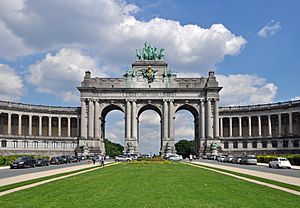
Leopold commissioned a great number of buildings, urban projects and public works, largely with the profits generated from exploitation of the Congo Free State. These projects earned him the epithet of "Builder King" (Dutch: Koning-Bouwheer, French: Roi-Bâtisseur). The public buildings were mainly in Brussels, Ostend, Tervuren and Antwerp, and include the Parc du Cinquantenaire/Jubelpark (1852-1880), memorial arcade and complex, the Basilica of the Sacred Heart (1905-1969) and Duden Park in Brussels (1881); the Hippodrome Wellington racetrack (1883), the Royal Galleries and Maria Hendrikapark in Ostend (1902); the Royal Museum for Central Africa and its surrounding park in Tervuren (1898); and Antwerpen-Centraal railway station in Antwerp (1895–1905).
In addition to his public works, Leopold acquired and built numerous private properties for himself inside and outside Belgium. He expanded the grounds of the Royal Castle of Laeken, and built the Royal Greenhouses, as well as the Japanese Tower and the Chinese Pavilion near the palace (now the Museums of the Far East). In the Ardennes, his domains consisted of 6,700 hectares (17,000 acres) of forests and agricultural lands and the châteaux of Ardenne, Ciergnon, Fenffe, Villers-sur-Lesse and Ferage. He also built important country estates on the French Riviera, including the Villa des Cèdres and its botanical garden, and the Villa Leopolda.
Thinking of the future after his death, Leopold did not want the collection of estates, lands and heritage buildings he had privately amassed to be scattered among his daughters, each of whom was married to a foreign prince. In 1900, he created the Royal Trust, by means of which he donated most of his properties to the Belgian nation in perpetuity, and arranged for the royal family to continue using them after his death.
Congo Free State
Leopold was the founder and sole owner of the Congo Free State, a private project undertaken on his own behalf. He used explorer Henry Morton Stanley to help him lay claim to the Congo, an area now known as the Democratic Republic of the Congo. At the Berlin Conference of 1884–1885, the colonial nations of Europe authorised his claim by committing the Congo Free State to improving the lives of the people.
From the beginning, Leopold ignored these conditions. He ran the Congo using the mercenary Force Publique for his personal enrichment. Failure to meet rubber collection quotas was punishable by death. Leopold extracted a fortune from the Congo, initially by the collection of ivory, and after a rise in the price of rubber in the 1890s, by forced labour from the people to harvest and process rubber.
Under his regime, millions of Congolese inhabitants were killed or died from disease and famine.
The Congo Free State was transformed into a Belgian colony under parliamentary control known as the Belgian Congo. Leopold went to great lengths to conceal potential evidence of wrongdoing during his time as ruler of his private colony. The entire archive of the Congo Free State was burned and he told his aide that even though the Congo had been taken from him, "they have no right to know what I did there". Congo achieved independence in 1960.
Death
On 17 December 1909, Leopold II died at Laeken, and the Belgian crown passed to Albert I, the son of Leopold's brother, Philippe, Count of Flanders. His funeral cortege was booed by the crowd in expression of disapproval of his rule. Leopold's reign of exactly 44 years remains the longest in Belgian history. He was interred in the royal vault at the Church of Our Lady of Laeken.
Family
Leopold's sister became the Empress Carlota of Mexico. His first cousins included both Queen Victoria of the United Kingdom and her husband Prince Albert, as well as King Fernando II of Portugal.
He had four children with Queen Marie Henriette, of whom the youngest two have descendants living as of 2018[update]:
- Princess Louise of Belgium, born in Brussels on 18 February 1858, and died at Wiesbaden on 1 March 1924. She married Prince Philipp of Saxe-Coburg and Gotha on 4 February 1875, they had two children and divorced on 15 January 1906.
- Prince Leopold, Duke of Brabant, Count of Hainaut (as eldest son of the heir apparent), later Duke of Brabant (as heir apparent), born at Laeken on 12 June 1859, and died at Laeken on 22 January 1869, from pneumonia, after falling into a pond.
- Princess Stéphanie of Belgium, born at Laeken on 21 May 1864, and died at the Archabbey of Pannonhalma in Győr-Moson-Sopron, Hungary, on 23 August 1945.
- Princess Clémentine of Belgium, born at Laeken on 30 July 1872, and died at Nice on 8 March 1955. She married Prince Napoléon Victor Jérôme Frédéric Bonaparte (1862–1926), head of the Bonaparte family. The current head of the Imperial family, Jean-Christophe, Prince Napoléon is a direct descendant of King Leopold II.
Leopold also fathered two sons by Caroline Lacroix. They were adopted in 1910 by Lacroix's second husband, Antoine Durrieux. Leopold granted them courtesy titles that were honorary, as the parliament would not have supported any official act or decree:
- Lucien Philippe Marie Antoine (9 February 1906 – 15 November 1984)Duke of Tervuren; he married Lucie Gracieuse Mundutey (30 October 1900 – 8 February 2005) on 1 March 1927.
- Philippe Henri Marie François (16 October 1907 – 21 August 1914) Count of Ravenstein
Ancestry
| Ancestors of Leopold II of Belgium | |||||||||||||||||||||||||||||||||||||||||||||||||||||||||||||||||||||||||||||||||||||||||||||||||||||||||||||||||||||||||||||||||||||||||||||||||||||||||||||||||||||||||||||||||||||||||||||||||||||||||||||||||||||||||||||||||||||||||||||||||||||||||||||||||||||||||||||||||||||||||
|---|---|---|---|---|---|---|---|---|---|---|---|---|---|---|---|---|---|---|---|---|---|---|---|---|---|---|---|---|---|---|---|---|---|---|---|---|---|---|---|---|---|---|---|---|---|---|---|---|---|---|---|---|---|---|---|---|---|---|---|---|---|---|---|---|---|---|---|---|---|---|---|---|---|---|---|---|---|---|---|---|---|---|---|---|---|---|---|---|---|---|---|---|---|---|---|---|---|---|---|---|---|---|---|---|---|---|---|---|---|---|---|---|---|---|---|---|---|---|---|---|---|---|---|---|---|---|---|---|---|---|---|---|---|---|---|---|---|---|---|---|---|---|---|---|---|---|---|---|---|---|---|---|---|---|---|---|---|---|---|---|---|---|---|---|---|---|---|---|---|---|---|---|---|---|---|---|---|---|---|---|---|---|---|---|---|---|---|---|---|---|---|---|---|---|---|---|---|---|---|---|---|---|---|---|---|---|---|---|---|---|---|---|---|---|---|---|---|---|---|---|---|---|---|---|---|---|---|---|---|---|---|---|---|---|---|---|---|---|---|---|---|---|---|---|---|---|---|---|---|---|---|---|---|---|---|---|---|---|---|---|---|---|---|---|---|---|---|---|---|---|---|---|---|---|---|---|---|---|---|---|---|
|
|||||||||||||||||||||||||||||||||||||||||||||||||||||||||||||||||||||||||||||||||||||||||||||||||||||||||||||||||||||||||||||||||||||||||||||||||||||||||||||||||||||||||||||||||||||||||||||||||||||||||||||||||||||||||||||||||||||||||||||||||||||||||||||||||||||||||||||||||||||||||
Titles and styles
- 9 April 1835 – 17 December 1865 His Royal Highness The Duke of Brabant, Prince of Saxe-Coburg and Gotha. Duke in Saxony.
- 17 December 1865 – 17 December 1909 His Majesty The King of The Belgians. Prince of Saxe-Coburg and Gotha, Duke in Saxony.
Images for kids
See also
 In Spanish: Leopoldo II de Bélgica para niños
In Spanish: Leopoldo II de Bélgica para niños


